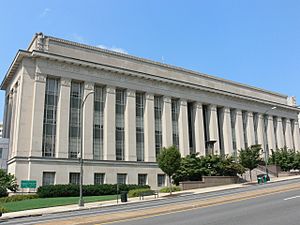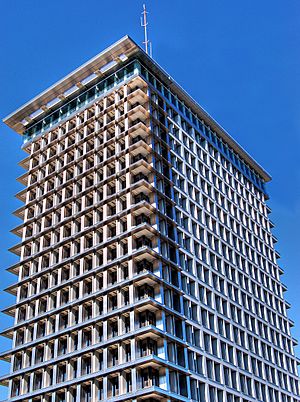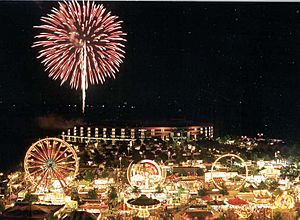Government of Virginia facts for kids
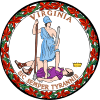
|
|
| Polity type | Presidential System |
|---|---|
| Constitution | Constitution of Virginia |
| Legislative branch | |
| Name | General Assembly |
| Type | Bicameral |
| Meeting place | Virginia State Capitol |
| Upper house | |
| Name | Senate |
| Presiding officer | Winsome Sears, President |
| Lower house | |
| Name | House of Delegates |
| Presiding officer | Don Scott, Speaker |
| Executive branch | |
| Head of State and Government | |
| Title | Governor |
| Currently | Glenn Youngkin |
| Appointer | Election |
| Cabinet | |
| Name | Governor's Cabinet |
| Leader | Governor |
| Deputy leader | Lieutenant Governor |
| Headquarters | State Capitol |
| Judicial branch | |
| Name | Judiciary of Virginia |
| Courts | Courts of Virginia |
| Supreme Court of Virginia | |
| Chief judge | Donald W. Lemons |
| Seat | Richmond |
The government of Virginia is how the state of Virginia is run. It has three main parts: the executive, legislative, and judicial branches. These branches work together to make sure the state runs smoothly.
The current Governor of Virginia is Glenn Youngkin. The State Capitol building in Richmond is where many government activities happen. It was designed by Thomas Jefferson. Its first stone was put in place by Governor Patrick Henry in 1785. Virginia's government follows the rules set in its 1971 Constitution of Virginia. This is the seventh constitution Virginia has had.
Contents
Executive Branch: Leading the State
The executive branch is like the management team for Virginia. It carries out the laws. The main elected leaders in this branch are the Governor, Lieutenant Governor, and Attorney General.
These three leaders are chosen by voters for four-year terms. Their elections happen in years after presidential elections. For example, the last election was in 2021. Virginia is one of only five states that elects its top officials in odd-numbered years.
The Governor's Role
The Governor is the chief executive officer of Virginia. This means they are the main leader of the state. The Governor is also the commander-in-chief of Virginia's military forces. Virginia's Constitution does not allow a governor to serve two terms in a row. However, a governor can serve multiple terms if there is a break in between.
Glenn Youngkin, a Republican, is the current Governor.
Lieutenant Governor and Attorney General
The Lieutenant Governor is not elected on the same ballot as the Governor. They serve as the president of the Senate of Virginia. If the Governor cannot do their job, the Lieutenant Governor takes over. The Lieutenant Governor can run for reelection.
Winsome Sears, a Republican, is the Lieutenant Governor. She is the first Black female Lieutenant Governor in Virginia's history.
The Attorney General is the state's chief legal advisor. They give legal advice to the Governor and the General Assembly. The Attorney General is also the head lawyer for Virginia. If both the Governor and Lieutenant Governor cannot serve, the Attorney General is next in line.
Jason Miyares, a Republican, is the Attorney General. He is the first Latino person elected to a statewide office in Virginia. If all three of these offices become empty, the Speaker of the Virginia House of Delegates becomes Governor.
Governor's Cabinet: Team of Advisors
The Virginia Governor's Cabinet is a group of important officials. They are chosen by the Governor to help advise them. These officials lead different departments that manage state services. The Virginia General Assembly must approve these appointments.
The Cabinet includes:
- Chief of Staff
- Deputy Chief of Staff
- Secretary of the Commonwealth
- Secretary of Administration
- Secretary of Agriculture and Forestry
- Secretary of Commerce and Trade
- Secretary of Education
- Secretary of Finance
- Secretary of Health and Human Resources
- Secretary of Natural Resources
- Secretary of Public Safety
- Secretary of Transportation
- Secretary of Veterans Affairs and Homeland Security
Legislative Branch: Making Laws
The legislative branch is responsible for making laws for Virginia. This branch is called the General Assembly. It has two parts, which is known as bicameral.
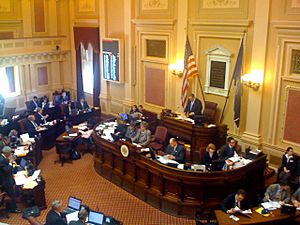
House of Delegates and Senate
The General Assembly includes:
- The Virginia House of Delegates: This is the lower house with 100 members.
- The Senate of Virginia: This is the upper house with 40 members.
Together, there are 140 elected representatives. Each represents a specific area in Virginia. The General Assembly meets at the Virginia State Capitol in Richmond.
The Speaker of the House leads the House of Delegates. The lieutenant governor of Virginia leads the Senate. Both the House and Senate choose their own clerk and sergeant-at-arms. The laws made by the General Assembly are written down in the Code of Virginia.
Judiciary: Interpreting Laws
The judiciary branch is Virginia's court system. It makes sure laws are fair and followed. The rules for the courts are in the Constitution of Virginia and law of Virginia.

Virginia's Court System
The highest court is the Supreme Court of Virginia. Below it are other courts, including:
- The Court of Appeals
- The Circuit Courts
- The General District Courts
The chief justice of the Supreme Court leads the court system. Various councils and committees also help manage the courts.
Local Government: Running Cities and Counties
Virginia is divided into different areas for government. These are called political subdivisions. They only have the powers that the General Assembly gives them.
Counties and Cities
Every place in Virginia is either in a county or an independent city. It is never both. Virginia has 95 counties and 39 independent cities. All of these have their own governments.
- Cities are usually led by an elected mayor or city council. They often hire a city manager to handle daily operations.
- Counties are led by a county board of supervisors.
Virginia has a rule called "Dillon's Rule." This rule limits what laws cities and counties can make. They can only pass laws that the state legislature specifically allows.
Local Officers
Local governments also have important officers. Some of these are called "constitutional officers." Their jobs are described in the Virginia Constitution.
These officers are elected by the voters in each county and city:
- Treasurer
- Sheriff
- Attorney for the Commonwealth
- Clerk (who handles court records)
- Commissioner of Revenue
These officers are not chosen by the city or county government. This gives them some independence. Judges for the Circuit Court and other district courts are chosen by the state legislature.
- The Attorney for the Commonwealth is the lawyer who brings criminal cases for the state in that area.
- The Sheriff is a law enforcement officer. They run the local jail, provide security for courthouses, and serve legal papers. They can also enforce criminal laws.
History of Virginia's Government
The Virginia General Assembly started in 1619. It is the oldest legislature in the New World that is still active today. In colonial Virginia, the lower part of the legislature was called the House of Burgesses.
Early Government in Colonial Times
The House of Burgesses worked with the Governor's Council to form the "General Assembly." The Governor's Council had 12 men chosen by the British monarch. They advised the governor and also acted as the colony's highest court.
People who could vote in the colony chose members for the House of Burgesses. Each county chose two "burgesses." Places like the College of William and Mary, Norfolk, Williamsburg, and Jamestown each chose one.
The Burgesses met to make laws and decide the colony's future. The Governor's Council and the Governor had to approve these laws. The idea of electing burgesses was new and important. It gave Virginians a chance to have a say in their own government. At first, all free men could vote. Later, voting rules changed, requiring men to own at least 50 acres of land to vote.
Changes Over Time
By the 1850s, Virginia had a state legislature, several executive officers, and a court system. The Constitution of 1901 lasted longer than any other state constitution. It kept the General Assembly as the legislature and the Supreme Court of Appeals as the judiciary. Eight executive officers were elected: the governor, lieutenant governor, attorney general, secretary of the commonwealth, state treasurer, auditor of public accounts, superintendent of public instruction, and commissioner of agriculture and immigration.
The 1901 Constitution was changed many times. In the 1930s and 1950s, there were big updates. Eventually, it was replaced by a more modern government system. This new system had fewer elected officials, updated local governments, and a more efficient court system.
See also
 In Spanish: Gobierno de Virginia para niños
In Spanish: Gobierno de Virginia para niños
- Politics of Virginia
- Elections in Virginia
- Republican Party of Virginia
- Democratic Party of Virginia
- Law of Virginia


